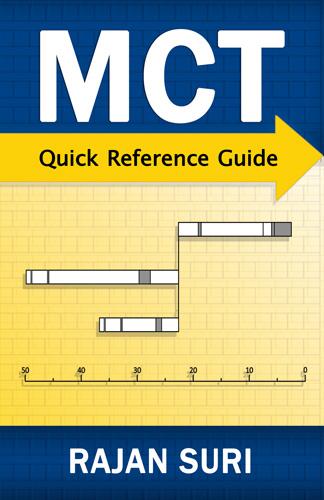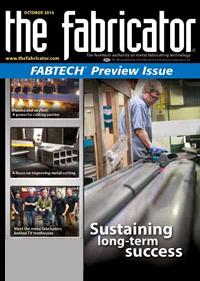Senior Editor
- FMA
- The Fabricator
- FABTECH
- Canadian Metalworking
Categories
- Additive Manufacturing
- Aluminum Welding
- Arc Welding
- Assembly and Joining
- Automation and Robotics
- Bending and Forming
- Consumables
- Cutting and Weld Prep
- Electric Vehicles
- En Español
- Finishing
- Hydroforming
- Laser Cutting
- Laser Welding
- Machining
- Manufacturing Software
- Materials Handling
- Metals/Materials
- Oxyfuel Cutting
- Plasma Cutting
- Power Tools
- Punching and Other Holemaking
- Roll Forming
- Safety
- Sawing
- Shearing
- Shop Management
- Testing and Measuring
- Tube and Pipe Fabrication
- Tube and Pipe Production
- Waterjet Cutting
Industry Directory
Webcasts
Podcasts
FAB 40
Advertise
Subscribe
Account Login
Search
Uncovering waste with an all-encompassing metric
Brief reference book shows that, in manufacturing, time is everything
- By Tim Heston
- October 22, 2014
- Article
- Shop Management
How long does it really take to manufacture a quality product, part, or subassembly? That’s a question Rajan Suri tackles in a recent book, MCT: Quick Reference Guide, and the answer isn’t as straightforward as you might think. In just 42 pages, Suri describes why asking the question is so important.
In the 1990s, Suri developed quick-response manufacturing (QRM), an improvement method suited for high-product-mix manufacturing. He’s the founding director of the Center for Quick Response Manufacturing at the University of Wisconsin-Madison (www.qrmcenter.org), and he has a message: Time really matters—in the broadest sense.
Shortening a process cycle time by 50 percent sounds impressive, but actual processing time (the time work is actually done to a part or order) is often less than 1 percent of what Suri calls MCT, or manufacturing critical-path time.
MCT isn’t lead-time, which may be quite short, especially if a customer pulls from a fabricator’s finished-goods inventory. Suri instead defines it as “the typical amount of calendar time from when a customer submits an order, through the critical path, until the first end-item of that order is delivered to the customer.” The book explains each phrase in this definition carefully. For instance, “customer submits an order” should be “when the clock starts as far as the customer is concerned.” If certain items are ordered or built before a customer pulls the trigger on an order, those items should be part of the MCT.
Custom fabricators make many different parts, of course, so Suri recommends that they apply the MCT analysis to a product or product family experiencing problems. He also suggests separating products into groups that make sense for the fabricator’s job mix, and developing an MCT map for each: one for small-quantity orders and another for large ones, for example, or one for first-time orders and another for repeat work.
Suri divides MCT into what he calls “white-space” and “gray-space” time. He describes gray space as when “someone is actually working on the order,” while white space is when “nothing is happening to the order.” This, he says, eliminates subjectivity that sometimes comes with the “valued-added” and “non-value-added” terminology. Does a certain inspection activity, one that the customer doesn’t require, add value? Some say it does, because it ensures quality and helps standardize procedures for a job shop’s diversified customers, many of which do require such inspection. Others may say that such inspection represents overprocessing, a classic waste of lean manufacturing.
According to Suri, MCT puts everything in a simple perspective. When a manufacturer fulfills an order, time passes, and people either spend time working on that order (gray space) or they don’t (white space)—period. In fact, when calculating the gray-space time, Suri advises that in some situations, shops shouldn’t sweat the details, be they slight variations in labor inputs, machine cycle time, or anything else. When he maps out a typical MCT in a bar chart, with blocks of white peppered with slivers of gray, you can see his point immediately: In most manufacturing environments, a lot of time passes when nothing whatsoever happens to the job, and finding out why can help you get the biggest bang out of your improvement buck. The visual impact of that white and gray space is so important, he put it on the cover of his book.
To create a map you need to know the boundaries—the start and end points. In most situations, the end point occurs when the first “end item” is delivered to the customer. Suri defines end item as “the first usable set of items.” A few parts of an order delivered early may look nice, but they don’t have any value until the customer has enough of an order to put it to use.
Then there’s the starting point of MCT, and in contract manufacturing, this can get complicated. You could say that a job starts when it’s released to the floor, but for certain jobs this ignores all the front-office processing, including engineering, customer communications, purchasing, programming, and scheduling. How about starting MCT when the customer submits a purchase order? This can work, but what if a fabricator has a blanket order and works from a rolling-horizon forecast? As Suri explains, there is no “right” way to define when a job starts, but he offers several options. If a fabricator initiates production, then MCT “can start at the moment when the forecast becomes firm.”
MCT also can start when the blanket order is first put in place. This kind of map “will initiate discussions, such as ‘Do we already start purchasing raw material or engage in other activities during this time?’ In fact, this map is likely to provide a surprisingly long MCT and a very large amount of white space, thus highlighting significant opportunities for discussion and improvement.”
Shortening MCT increases a fabricator’s available capacity and reduces operating costs. As Suri states, “Less time is spent on planning, scheduling, expediting, and so on. Fewer resources are involved in warehousing and material handling. There is less investment in inventory, space, and possible obsolescence of materials.”
Because it’s so effective, shortening the MCT can be the goal for everybody in the enterprise, serving as the baseline for employee performance and incentive programs. He also sees big implications for using MCT as a metric to gauge the quality of suppliers. A fabricator may draw parts from a supplier’s finished-goods inventory, meaning the lead-time is next to nothing. But how long did it really take for the supplier to make those parts? A supplier may offer a low price or even offer to hold finished-goods inventory, but if the supplier has a long MCT (as many overseas sources do), it won’t be able to respond quickly to changes. A long MCT in any organization slows its ability to adapt.
In fact, when you get right down to it, adapting to change is what modern manufacturing, or any business for that matter, is all about.
For more information on Rajan Suri, visit www.rajansuri.com.
About the Author

Tim Heston
2135 Point Blvd
Elgin, IL 60123
815-381-1314
Tim Heston, The Fabricator's senior editor, has covered the metal fabrication industry since 1998, starting his career at the American Welding Society's Welding Journal. Since then he has covered the full range of metal fabrication processes, from stamping, bending, and cutting to grinding and polishing. He joined The Fabricator's staff in October 2007.
subscribe now

The Fabricator is North America's leading magazine for the metal forming and fabricating industry. The magazine delivers the news, technical articles, and case histories that enable fabricators to do their jobs more efficiently. The Fabricator has served the industry since 1970.
start your free subscription- Stay connected from anywhere

Easily access valuable industry resources now with full access to the digital edition of The Fabricator.

Easily access valuable industry resources now with full access to the digital edition of The Welder.

Easily access valuable industry resources now with full access to the digital edition of The Tube and Pipe Journal.
- Podcasting
- Podcast:
- The Fabricator Podcast
- Published:
- 04/16/2024
- Running Time:
- 63:29
In this episode of The Fabricator Podcast, Caleb Chamberlain, co-founder and CEO of OSH Cut, discusses his company’s...
- Industry Events
16th Annual Safety Conference
- April 30 - May 1, 2024
- Elgin,
Pipe and Tube Conference
- May 21 - 22, 2024
- Omaha, NE
World-Class Roll Forming Workshop
- June 5 - 6, 2024
- Louisville, KY
Advanced Laser Application Workshop
- June 25 - 27, 2024
- Novi, MI
































